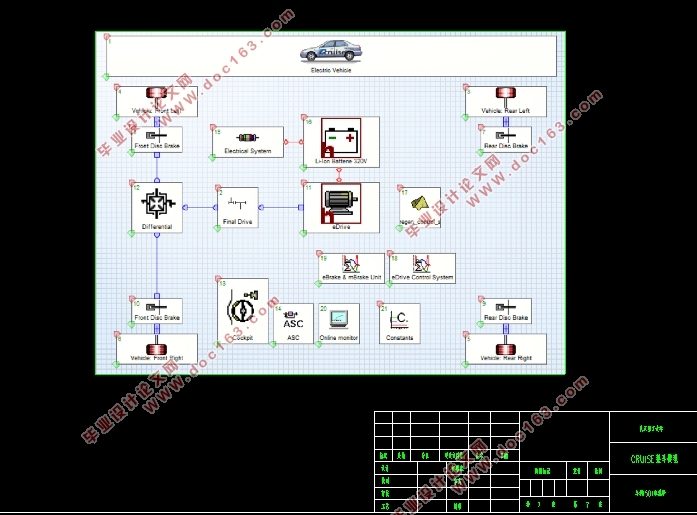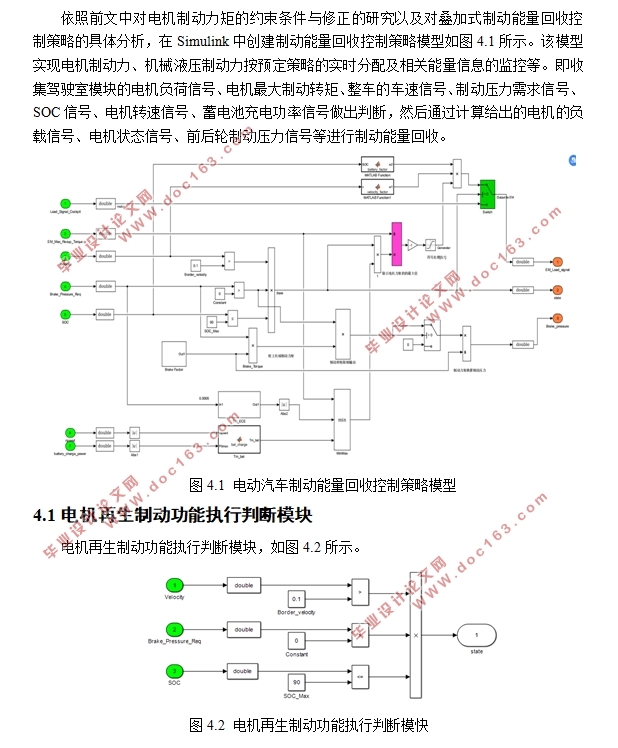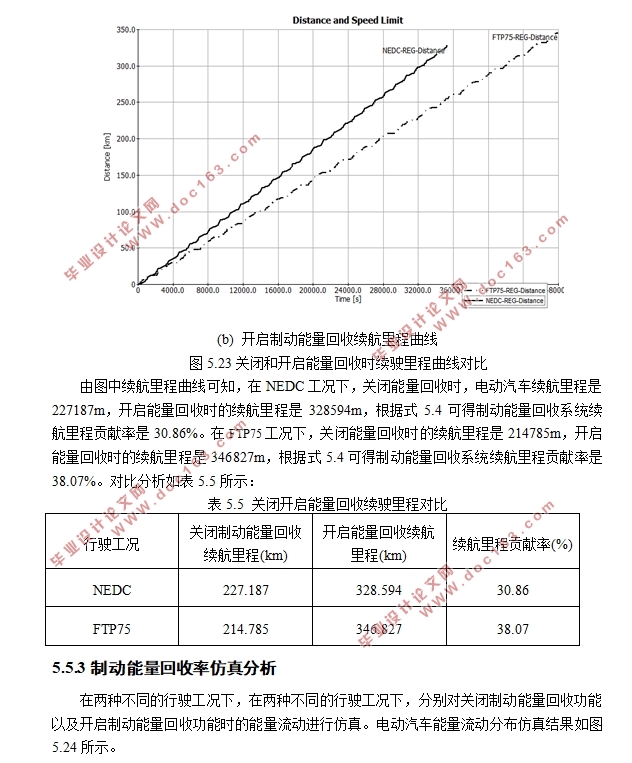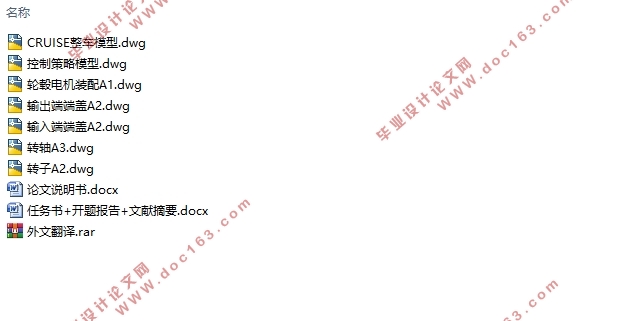基于锂电池的电动汽车制动能量回收系统开发研究(含CAD零件装配图)

基于锂电池的电动汽车制动能量回收系统开发研究(含CAD零件装配图)(任务书,开题报告,文献摘要,外文翻译,论文说明书30000字,CAD图7张)
摘要
石油等传统、非清洁能源的过度使用,导致了许多突出的负面问题,例如能源危机、环境污染、大气变暖等。以汽油为动力源的传统燃油汽车,发展也受到了这一现状的限制,显得后力不足。随之而来的今天,新能源汽车,尤其是电动汽车,跟传统内燃机车辆相比,在市场与前景等各方面有着非常大的优势,已然成为了一个热门的能源领域研究主题。
虽然电动汽车现在势头正猛,但是仍存在着续航能力较短、充电不方便等不足之处。电动汽车采用电动机进行驱动,完成能量转换。在车辆进行制动时,电机产生的电机制动,与机械制动共同作用,这可以一定程度上减轻机械制动系统的负担,还可以实现能量回收,提高了整车的续驶里程。因此,研发电动汽车制动能量回收技术,不光能在一定程度上解决能源危机问题、减少环境污染等,而且对汽车产业尤其是电动汽车产业也具有非常积极的意义。
本文进行锂电池电动汽车制动能量回收系统的研究。制动能量回收系统,不光要求要有着较高的制动能量回收率,也要求要有良好的车辆制动性能。本文从确定汽车整车参数、动力系统主要零部件的选型和参数出发,先后分析了电动汽车制动能量回收系统的结构与原理、典型的制动能量回收控制策略,并选取叠加式制动能量回收控制策略。之后,在SIMULINK软件中,建立了选取的控制策略模型。最后利用AVL CRUISE软件与SIMULINK软件进行联合仿真,在选定常用的循环工况后,对该制动能量回收控制策略进行了评价分析,验证所提出的控制策略的有效性。比照开启、关闭制动能量回收功能时的相关仿真结果。计算分析三个评价指标:续驶里程贡献率,制动能量回收效率,电池SOC值变化。三项指标下,能量回收的功能均得到了很好的实现。
关键词:锂电池电动汽车;制动能量回收;控制策略; CRUISE; 联合仿真
Abstract
The excessive use of traditional and non-clean energy, such as oil, has led to many outstanding negative problems, such as energy crisis, environmental pollution, atmospheric warming and so on. The development of traditional fuel-fired automobiles powered by gasoline is also limited by the present situation, which expresses a poor prospect for development. Nowadays, compared with traditional internal combustion engine vehicles, new energy vehicles, especially electric vehicles, have great advantages in the market and prospects, and become a popular research topic in the field of energy.
Although electric vehicles have had a fast development, there are still shortcomings such as short endurance and inconvenient charging. Electric vehicles are driven by motors to complete energy conversion. When the vehicle is braking, the motor braking produced by the motor and the mechanical braking work together, which can reduce the burden of the mechanical braking system to a certain extent, can also achieve energy recovery, and improve the driving range of the vehicle. Therefore, the research and development of braking energy recovery technology for electric vehicles not only can solve the energy crisis and reduce environmental pollution to a certain extent, but also has a very positive significance for the automotive industry, especially for the electric vehicle industry. [来源:http://www.doc163.com]
In this paper, the main research content is the braking energy recovery system of electric vehicle.Braking energy recovery system requires not only a high braking energy recovery rate, but also a good vehicle braking performance. Starting from the choices of vehicle parameters, the selection of main parts and parameters of power system, the structure and principle of braking energy recovery system of electric vehicle, typical control strategy of braking energy recovery are analyzed successively, and superimposed control strategy of braking energy recovery is selected. Then, in SIMULINK software, the selected control strategy model is established. Finally, the AVL CRUISE software and SIMULINK software are used for joint simulation. After choosing the common cycle conditions, the braking energy recovery control strategy is evaluated and analyzed, and the effectiveness of the proposed control strategy is verified. The simulation results of opening and closing the braking energy recovery function are compared. Three evaluation indicators were calculated and analyzed,including the contribution rate of driving mileage ,the recovery efficiency braking energy and the change of the SOC value. Under the three indicators, the function of energy recovery has been well realized.
[资料来源:www.doc163.com]
Key Words:Lithium battery electric vehicle; Brake energy recovery; Control strategy; CRUISE; Joint simulation
电动汽车整车基本参数
整车基本参数 整备质量m 1753kg
满载质量m0 2128kg
长×宽×高 4694mm×1850mm×1443mm
轴距 2875mm
轮距 1580mm
迎风面积A 2.67m²
风阻系数Cd 0.30
轮胎型号 235/45R18
轮胎滚动半径r 334.35mm
滚动阻力系数f 0.012
质心到前后轴距离 1291mm/1584mm
质心高度 50cm
传动系统传动比 7.36
[资料来源:www.doc163.com]





目录
第 1 章 绪论 1
1.1 研究背景及研究意义 1
1.2 电动汽车制动能量回收技术研究现状 2
1.2.1 电动汽车发展现状 2
1.2.2 国外电动汽车制动能量回收技术研究现状 3
1.2.3 国内电动汽车制动能量回收技术研究现状 4
1.3 研究的基本内容 5
第 2 章 电动汽车动力系统主要零部件的设计 6
2.1 电动汽车整车参数和性能指标 7
2.2 动力系统主要零部件的设计 8
2.2.1 驱动电机的选型 8
2.2.2 驱动电机的参数匹配 8
2.2.3 动力电池的选型 13
2.2.4 动力电池的参数匹配 15
2.2.5 传动系统参数匹配 17
2.3 本章小结 18
第 3 章 电动汽车制动能量回收控制策略研究 19
3.1 电动汽车制动能量回收系统分析 19
3.1.1 电动汽车制动能量回收系统的组成 19
3.1.2 电动汽车制动能量回收系统的分类 20
3.1.3 电动汽车制动能量回收系统的工作原理 21
3.2 制动能量回收的约束条件 22
3.2.1 电机特性的影响 22
3.2.2 动力电池的影响 23
3.2.3 制动安全性的影响 23
3.2.4 车辆行驶工况的影响 24
3.2.5 控制策略的影响 24
3.3 汽车制动过程的动力学分析 24
3.3.1 传统汽车前后轴制动力的分配 24
3.3.2 电动汽车前后轴制动力的分配 25
3.4 电机制动力矩的制约条件 26
3.4.1 ECE法规对M1类车辆的规定 26
3.4.2 ECE法规下β的规定 28
3.4.3 电机制动力矩的确定和修正 29
3.5 典型制动能量回收控制策略研究 33
3.5.1 理想制动力分配控制策略 33
3.5.2 比例制动力分配控制策略 34
3.5.3 最优制动能量回收控制策略 34
[来源:http://Doc163.com]
3.5.4 本文拟采用的控制策略 35
3.6 本章小结 36
第 4 章 电动汽车制动能量回收控制策略建模 37
4.1 电机再生制动功能执行判断模块 37
4.2 ECE法规限制下的电机可用制动力矩计算模块 38
4.3 电池充电功率限制下的电机可用制动力矩计算模块 38
4.4 电机再生制动负载信号计算模块 39
4.5 电机再生制动负载信号修正模块 39
4.6 本章小结 39
第 5 章 制动能量回收控制策略的仿真分析 40
5.1 前向仿真和后向仿真 40
5.2 AVL CRUISE软件中整车模型搭建 40
5.2.1 整车模型搭建 41
5.2.2 建立信号连接 42
5.2.3 子系统模块参数设定 42
5.2.4 定制仿真任务和进行仿真计算 47
5.2.5 API接口与DLL接口的比较与选定 48
5.3 电动汽车制动能量回收系统评价指标 48 [资料来源:www.doc163.com]
5.4 车辆动力性能和经济性能的仿真分析 49
5.5 制动能量回收控制策略的仿真分析 53
5.5.1 循环工况的设定 53
5.5.2 续航里程贡献率仿真分析 55
5.5.3 制动能量回收率仿真分析 56
5.5.4 电池SOC 变化分析 59
5.5.5 本章小结 60
第 6 章 总结与展望 61
6.1 研究总结 61
6.2 研究展望 61
参考文献 62
附录 65
致谢 71 [资料来源:http://doc163.com]
上一篇:用于电动汽车增程器的燃料电池热管理研究(含CAD零件装配图)
下一篇:EQ1092F8AD1型长头柴油载货汽车后悬设计(英文版)(含CAD图)
